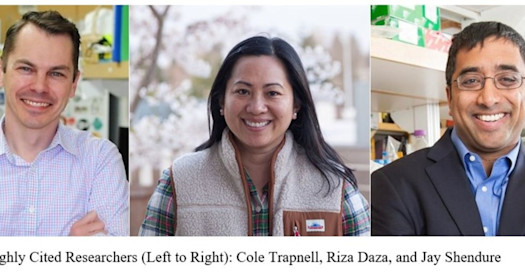
A manuscript published by BBI researchers Junyue Cao, Cole Trapnell and Jay Shendure profiled ~2 million cells, derived from 61 embryos staged between 9.5 and 13.5 days of gestation, in a single experiment. They identified hundreds of cell types and 56 trajectories, and collectively define thousands of corresponding marker genes and dynamics of gene expression within cell types and trajectories over time.
The single-cell transcriptional landscape of mammalian organogenesis Article | Published: 20 February 2019 Nature 566, 496–502 (2019)
Abstract: Mammalian organogenesis is a remarkable process. Within a short timeframe, the cells of the three germ layers transform into an embryo that includes most of the major internal and external organs. Here we investigate the transcriptional dynamics of mouse organogenesis at single-cell resolution. Using single-cell combinatorial indexing, we profiled the transcriptomes of around 2 million cells derived from 61 embryos staged between 9.5 and 13.5 days of gestation, in a single experiment. The resulting ‘mouse organogenesis cell atlas’ (MOCA) provides a global view of developmental processes during this critical window. We use Monocle 3 to identify hundreds of cell types and 56 trajectories, many of which are detected only because of the depth of cellular coverage, and collectively define thousands of corresponding marker genes. We explore the dynamics of gene expression within cell types and trajectories over time, including focused analyses of the apical ectodermal ridge, limb mesenchyme and skeletal muscle.
Explore the data Trajectories: Explore our cell trajectories and sub trajectories in 3D UMAP space. Clusters: Explore our cell clusters and sub clusters in t-SNE space. Genes: Search for the expression of a gene in cell clusters and sub clusters. Data Sets: We have made our primary and secondary data available for the research community along with extensive documentation. sci-RNA-seq3: To generate these data, we used a novel high throughput single cell RNA-seq technique called sci-RNA-seq3, which can profile millions of cells in a single experiment. sci-RNA-seq3 is an upgraded version of sci-RNA-seq, and is based on a methodological framework called combinatorial indexing to profile millions of cells or nuclei without single cell isolation.


